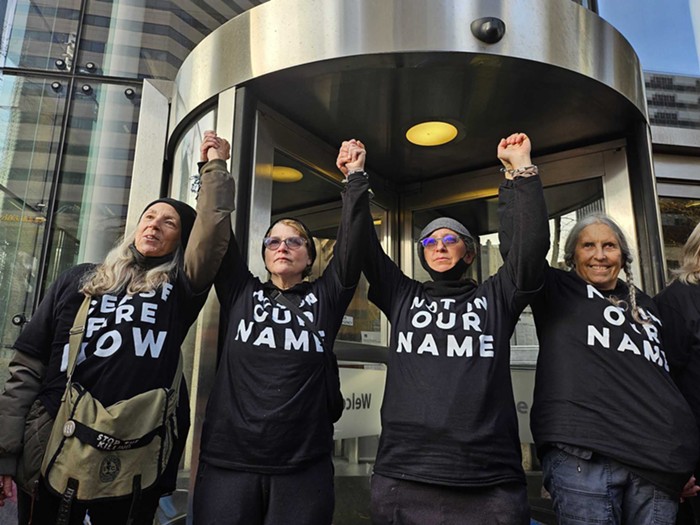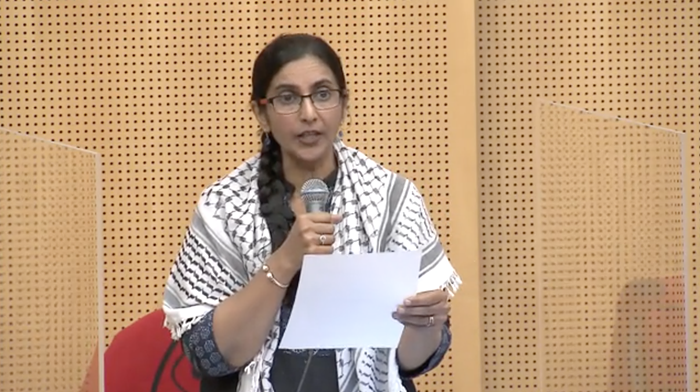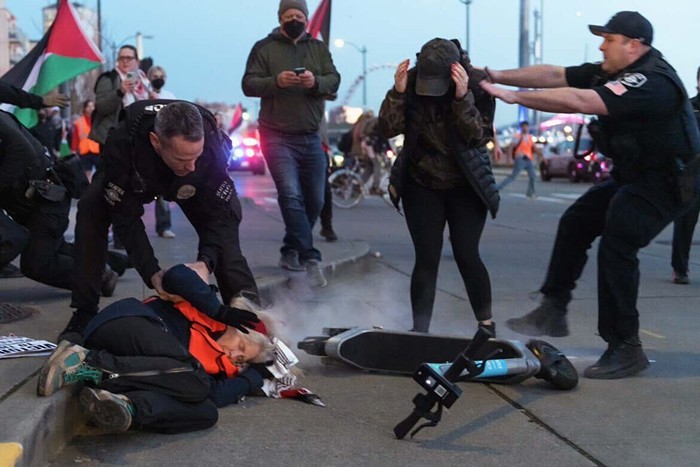If the name John Towery doesn't ring a bell, it should—he was the informant hired by the US Army to infiltrate, report on, and disrupt the peace activists of Port Militarization Resistance in south Puget Sound starting in 2007.
Earlier this week, federal judge Ronald B. Leighton dismissed a lawsuit accusing Towery of violating the civil rights of PMR protesters at the Army's behest when he began reporting on their activities, political beliefs, and personal lives, as well us trying to set up multi-agency surveillance group to track "leftist/anarchist" individuals. (There is also evidence that he attempted to entrap at least one activist by trying to persuade him to buy guns and learn to shoot.)
But lead attorney Larry Hildes says Judge Leighton's reasoning was "tortured"—the judge argued that Towery was spying legitimately, for the sake of protecting the safety of the troops and the demonstrators—and they will appeal the decision to the Ninth Circuit Court of Appeals, including a request for another judge. Judge Leighton, Hildes says, "admitted he had not read everything we’d submitted—but he read everything they submitted and quoted from it extensively, which was a shocker... To not read everything and then tell us we’d not provided enough evidence was pretty amazing."
The judge, Hildes says, also commented on the record that "he doesn't follow the rules" and has a long history of reluctance to rule against the government. "We had some real concerns" going in, Hildes says, "but we have a strong case, we know they broke the law over and over again, and we know there are laws prohibiting what they did. The Army admits in their report that Towery and Rudd [his supervisor] broke the regulations and committed major violations of posse comitatus." (Posse comitatus prevents the US military from engaging in domestic law enforcement.)
"Leaving what he [the judge] did alone," Hildes adds, "would cause irreparable harm to Constitution."
PMR's strategy around 2007 was simple and effective (which is, in part, why it drove the Army so crazy): They would blockade and disrupt Army shipments of personnel and gear as they made their way to the civilian ports of Olympia and Tacoma for deployment to Iraq and Afghanistan. The group was explicitly nonviolent—according to Hildes, even Army officials involved in the spying admitted as much during depositions—but committed a handful of acts of civil disobedience, such as sitting in the road, Tiananmen Square-style, to block Stryker convoys.
They successfully delayed brigades heading overseas, including the 5th brigade/2nd division (some of whose members were later convicted of killing civilians "for sport"), and others that eventually suffered heavy combat losses in Iraq. But, according to PMR activist Drew Hendricks, the demonstrations worked. "The military used the Port of Olympia 11 times between March 2004 and late 2007," Hendricks says, "and zero times since. Every time there was a PMR protest—in November of 2004, May and June of 2006, and November of 2007—there was an order of magnitude in the reduction in military shipments through Port of Olympia. PMR worked."
It got to the point, Hildes says, where convoys were leaving Joint Base Lewis-McChord in the middle of the night, under heavy police protection, to avoid encounters with PMR.
But the Army responded, according to Hildes, by treating the activists as enemy combatants and conducting intensive and invasive intelligence-gathering. "You can't take people engaged in First Amendment activity, because you don’t like the activity, and declare war on them," he says. "They didn’t shoot them, didn’t kill them, but used everything else in their arsenal" including reporting on their personal lives, political beliefs, and getting a few labeled as domestic terrorists.
Hildes and Hendricks say there are dossiers and PowerPoint presentations on some of the demonstrators that made the rounds at domestic terrorism conferences.
Some of the depositions of Army personnel, Hildes says, "are amazing." One colonel, he says, said "of course we monitor the peace movement because they're anti-military and might demonstrate against us." Another, Hildes says, "was like something out of Dr. Stranglove. 'There are no limits in intelligence-sharing to defend the homeland.' He said that three times!"
Hildes says another Army official bragged about their effectiveness in disrupting the lives of PMR demonstrators to her bosses in the Pentagon—and that there was a PMR task force at McGuire Air Force Base in New Jersey. "There’s no way they weren’t duplicating this model other places," he says.
Nevertheless, Hildes says he's "proud" of what PMR achieved. "It’s a big deal to stand or sit in front of a Stryker vehicle," he says. "If you have enough people doing that that you have to sneak the equipment out to avoid them, you do not have a popular war. You need to look at what you’re doing. That was the point. Instead of doing that, the military and law enforcement were looking for ways to destroy these people’s lives and their ability to organize."
If Judge Leighton's current ruling stands, Hildes says, "the Army can take any peace group, where any member of it has ever engaged in civil disobedience, which is probably most peace groups in the country, and spy on them as much as they want, gather personal information as much as they want, label them as terrorists as much as they want, and everything is okay. Nothing’s out of bounds. The ground where the First Amendment and Fourth Amendment coexist to protect dissent, if this ruling stands, will be gone."
Hildes says it will be a year, at least, before his legal team is able to make oral arguments in front of the Ninth Circuit Court of Appeals. "Everybody," he says, "is in it for the long haul."


















